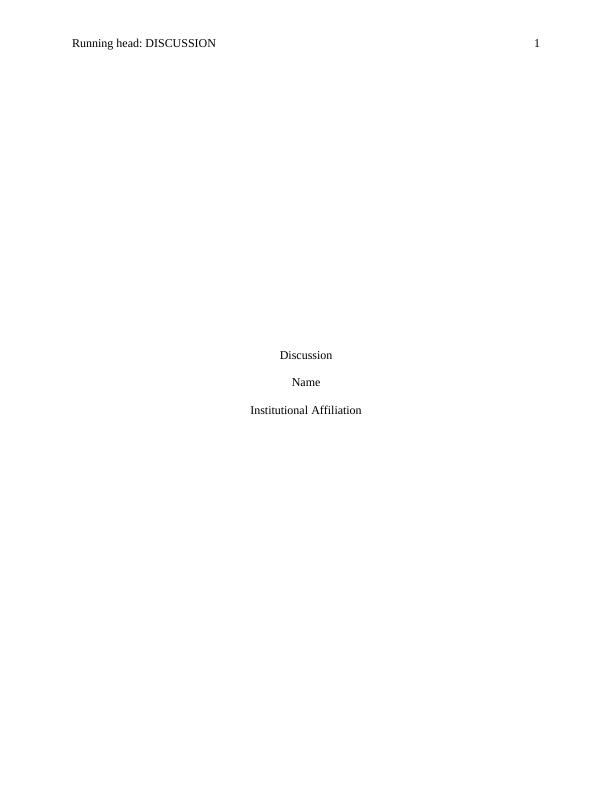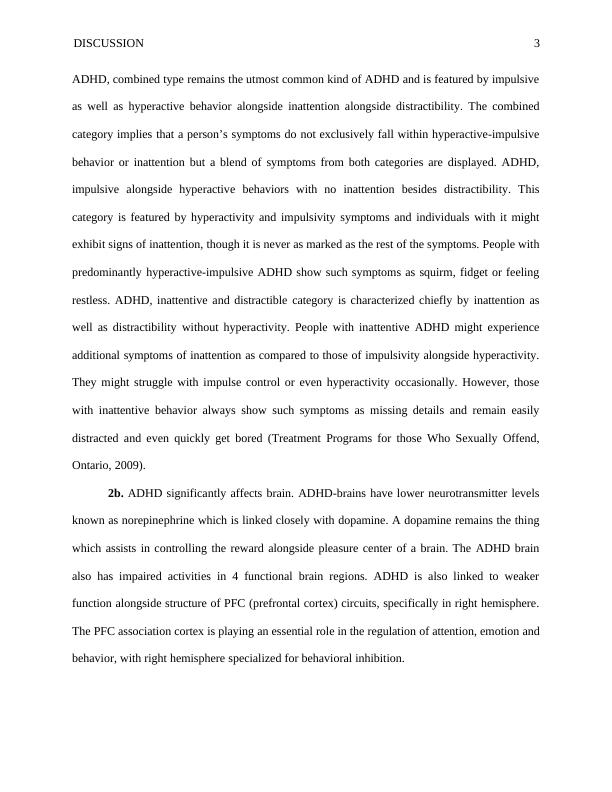Assignment on Neurological Disorder
Added on 2022-07-27
6 Pages1266 Words22 Views
Running head: DISCUSSION 1
Discussion
Name
Institutional Affiliation
Discussion
Name
Institutional Affiliation

DISCUSSION 2
DISCUSSION
SECTION A
Q1: a. Learning disability:
A learning disability remains a neurological disorder. In other words, a learning disability
arises from a variation in the manner in which an individual’s brain gets “wired.” Children with
learning disabilities remain smarter or smart than their respective peers. Young kids, adults and
adolescents with learning disability display confusing alongside contradictory profiles of
performance. They can perform some task very well whereas struggling substantially with other
tasks because of frustrations and outcomes. For instance, a kid might be extremely bright and
have a yearning for some knowledge, yet displays difficulty behaving suitably when put into a
reading cohort with peers. The kid often becomes overexcited and the tutor has to eliminate her
from cohort. A learning disability might also affects a child’s behavior by having a devastating
impact on his self-esteem. Despite the efforts teachers and parents towards the academic success
of the child, the recurrent disappointments as well as lack (ADHD and the Justice System, 2016).
1b. The higher prevalence of learning disability in offender population as compared to
general population. One of the reason for this prevalence is the association between LD and
crimes. It has been discovered that there is evidence to support the association between IQ and
offending with those in lower IQ category having higher rates of wrongdoing than those in
greater functioning categories. Even where SES is controlled for, offending conduct has been
noted to be substantially linked to IQ.
2. a. 3 categories associated with ADHD
There remain three categories of ADHD which encompass ADHD combined category,
ADHD impulsive/hyperactive type as well as ADHD inattentive and distractible type. The
DISCUSSION
SECTION A
Q1: a. Learning disability:
A learning disability remains a neurological disorder. In other words, a learning disability
arises from a variation in the manner in which an individual’s brain gets “wired.” Children with
learning disabilities remain smarter or smart than their respective peers. Young kids, adults and
adolescents with learning disability display confusing alongside contradictory profiles of
performance. They can perform some task very well whereas struggling substantially with other
tasks because of frustrations and outcomes. For instance, a kid might be extremely bright and
have a yearning for some knowledge, yet displays difficulty behaving suitably when put into a
reading cohort with peers. The kid often becomes overexcited and the tutor has to eliminate her
from cohort. A learning disability might also affects a child’s behavior by having a devastating
impact on his self-esteem. Despite the efforts teachers and parents towards the academic success
of the child, the recurrent disappointments as well as lack (ADHD and the Justice System, 2016).
1b. The higher prevalence of learning disability in offender population as compared to
general population. One of the reason for this prevalence is the association between LD and
crimes. It has been discovered that there is evidence to support the association between IQ and
offending with those in lower IQ category having higher rates of wrongdoing than those in
greater functioning categories. Even where SES is controlled for, offending conduct has been
noted to be substantially linked to IQ.
2. a. 3 categories associated with ADHD
There remain three categories of ADHD which encompass ADHD combined category,
ADHD impulsive/hyperactive type as well as ADHD inattentive and distractible type. The

DISCUSSION 3
ADHD, combined type remains the utmost common kind of ADHD and is featured by impulsive
as well as hyperactive behavior alongside inattention alongside distractibility. The combined
category implies that a person’s symptoms do not exclusively fall within hyperactive-impulsive
behavior or inattention but a blend of symptoms from both categories are displayed. ADHD,
impulsive alongside hyperactive behaviors with no inattention besides distractibility. This
category is featured by hyperactivity and impulsivity symptoms and individuals with it might
exhibit signs of inattention, though it is never as marked as the rest of the symptoms. People with
predominantly hyperactive-impulsive ADHD show such symptoms as squirm, fidget or feeling
restless. ADHD, inattentive and distractible category is characterized chiefly by inattention as
well as distractibility without hyperactivity. People with inattentive ADHD might experience
additional symptoms of inattention as compared to those of impulsivity alongside hyperactivity.
They might struggle with impulse control or even hyperactivity occasionally. However, those
with inattentive behavior always show such symptoms as missing details and remain easily
distracted and even quickly get bored (Treatment Programs for those Who Sexually Offend,
Ontario, 2009).
2b. ADHD significantly affects brain. ADHD-brains have lower neurotransmitter levels
known as norepinephrine which is linked closely with dopamine. A dopamine remains the thing
which assists in controlling the reward alongside pleasure center of a brain. The ADHD brain
also has impaired activities in 4 functional brain regions. ADHD is also linked to weaker
function alongside structure of PFC (prefrontal cortex) circuits, specifically in right hemisphere.
The PFC association cortex is playing an essential role in the regulation of attention, emotion and
behavior, with right hemisphere specialized for behavioral inhibition.
ADHD, combined type remains the utmost common kind of ADHD and is featured by impulsive
as well as hyperactive behavior alongside inattention alongside distractibility. The combined
category implies that a person’s symptoms do not exclusively fall within hyperactive-impulsive
behavior or inattention but a blend of symptoms from both categories are displayed. ADHD,
impulsive alongside hyperactive behaviors with no inattention besides distractibility. This
category is featured by hyperactivity and impulsivity symptoms and individuals with it might
exhibit signs of inattention, though it is never as marked as the rest of the symptoms. People with
predominantly hyperactive-impulsive ADHD show such symptoms as squirm, fidget or feeling
restless. ADHD, inattentive and distractible category is characterized chiefly by inattention as
well as distractibility without hyperactivity. People with inattentive ADHD might experience
additional symptoms of inattention as compared to those of impulsivity alongside hyperactivity.
They might struggle with impulse control or even hyperactivity occasionally. However, those
with inattentive behavior always show such symptoms as missing details and remain easily
distracted and even quickly get bored (Treatment Programs for those Who Sexually Offend,
Ontario, 2009).
2b. ADHD significantly affects brain. ADHD-brains have lower neurotransmitter levels
known as norepinephrine which is linked closely with dopamine. A dopamine remains the thing
which assists in controlling the reward alongside pleasure center of a brain. The ADHD brain
also has impaired activities in 4 functional brain regions. ADHD is also linked to weaker
function alongside structure of PFC (prefrontal cortex) circuits, specifically in right hemisphere.
The PFC association cortex is playing an essential role in the regulation of attention, emotion and
behavior, with right hemisphere specialized for behavioral inhibition.

End of preview
Want to access all the pages? Upload your documents or become a member.
Related Documents
Interview analysis Assignment PDFlg...
|10
|2881
|45
